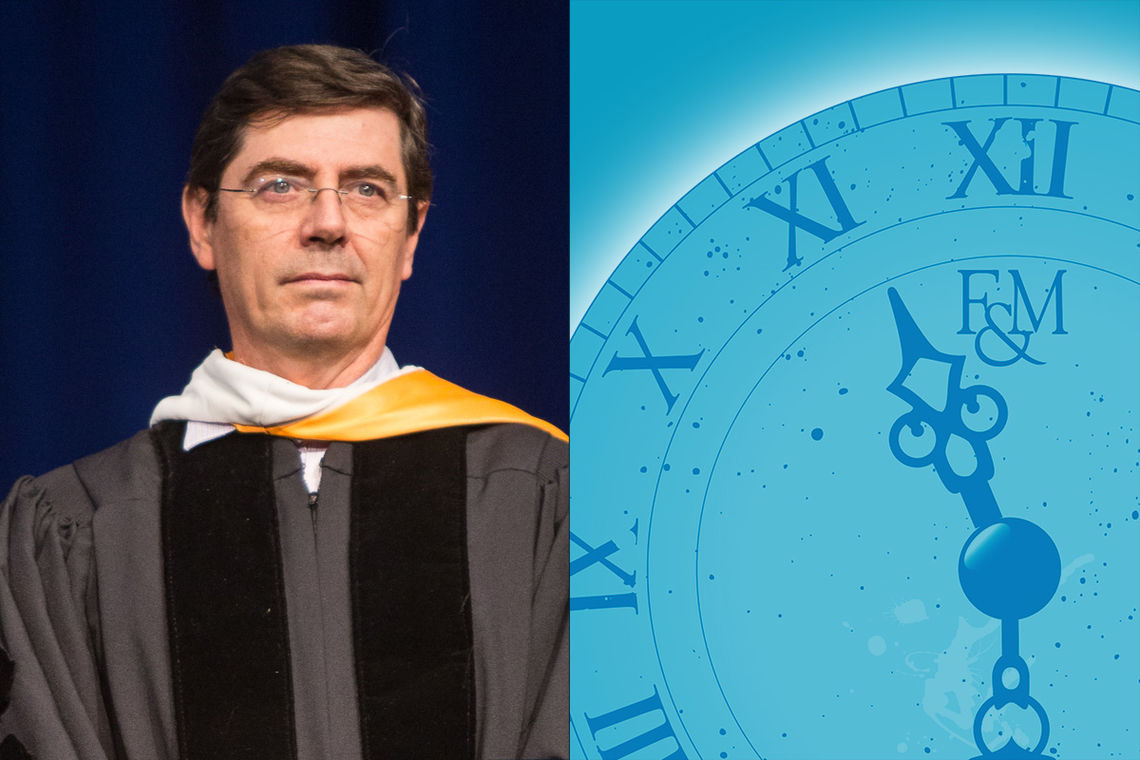By Christa Rodriguez || Campus Life Editor
This week’s Common Hour featured F&M Professor James Strick, who presented his talk, titled, “Sex, Lies and Bookburning: How Does a Scientist End up Getting His Books Burned by both the Nazis and the U.S. Government?” A member of the faculty for 14 years, Dr. Strick is a professor in the Department of Earth and Environment and the Chair of the interdisciplinary program Science, Technology, and Society. He is the recipient of the 2016 Bradley R. Dewey Award for Outstanding Scholarship.
He has also published many works on the history of ideas and experiments on the origin of life, and he is the editor of two collections of primary sources. In his presentation, he discussed his recent history of science project, which led to his book, Wilhelm Reich, Biologist.
James Strick told the story of Wilhelm Reich, a scientist and psychoanalyst who was jailed, his scientific books and journals burned by the Nazis and later by the United States. Strick worked for 25 years to answer questions he had about Reich’s story. Though Reich was an important innovator and a social and political theorist, his work was still considered pseudoscience. As Strick noted however, Reich took his science seriously and even conducted experiments and kept intensive laboratory notes.
Wilhelm Reich was a Freudian psychoanalyst and was well-educated. For part of his career, Reich looked into Freud’s libido theory. Reich did clinical research and discovered that people who had neurotic symptoms (like shell shock, or what today is called PTSD) found gratification in their sex lives. Strick said Reich’s found that “if libido was dammed up and not discharged” it would cause neurological problems.
Reich was a political leftist and even supported Marxism. As a German-Jewish scientist, Reich began to face hostility in his work environment and was soon under direct threat of persecution. In April 1933, he was forced to flee Germany. Harald Schjelderup, a Norwegian professor, invited Reich to carry out his libido experiments in the University of Oslo. Reich concluded that libido was bioelectrical energy, and began to ponder if this would apply to all living things.
Reich also conducted bion experiments, and collected and systematized knowledge about substances that affect the nervous system. Strick noted that in 1930s, there was a common experiment to combine chemicals to see what might have led to the origin of life, which Reich built off of. In the University of Oslo, he performed many experiments, and developed his own microcinematography setup to take pictures over time. Reich looked at cancer cells and saw that tissues low in energy, low in oxygen, or subject to carcinogens, formed cancer cells.
Reich’s experiments were important for understanding the origins of life and understanding the genesis of cancer, but went against existing scientific and religious beliefs. Others confirmed his findings, such as a Professor at a French university that actually replicated most of his experiments.
Strick showed handwritten notebook pages from Reich’s journals, noting of scientific notes in general that: “You get a feeling for the personality of the scientists.” When Strick was doing his research, there were challenges to reading scientist’s handwriting, especially in German. Reich’s handwriting was sloppy, but, according to Strick, not as hard to decipher as the writing of other scientists.
Otto Lous Mohr, a Norwegian doctor and professor at the University of Oslo, as well as an advocate for certain rights such as legalized abortion, birth control, sexual education in schools, had much in common with left-leaning Reich. However, Mohr still opposed him, saying his experiments were absolute nonsense, even though he never tried replicating them himself. Mohr wanted to distance himself from Reich as Norwegian socialists turned against Trotsky, and Reich was a Trotskyite.
More opposition to Reich’s work was evident in September 1937, when a proto-Nazist cartoon was published in a German newspaper, making fun of Reich and calling him a Jewish pornographer.
Leiv Kreyberg, a researcher on the genetics of cancer in mice, had connections with Mohr. Reich did not know this, and asked Kreyberg for help. Kreyberg declared that Reich’s work was flawed, which gave more credibility to the people who opposed Reich’s work.
There was an independent assessment 15 years later, now available in U.S. State Department archives, on whether scientists in Oslo thought Reich was a competent scientist. They found difficulties involved with assessment. Reich’s sexual theories, Marxist politics, and Jewish origins might be off-putting to a lot of people, which would cause many people to discredit to his work. They found that Kreyberg was hasty in his judgements, and often his emotional reactions appeared to override his scientific objectivity. They assessed other critics of Reich’s work as well.
Because of this widespread opposition, Reich could not get funding for his work, and could no longer stay in Norway, so he emigrated to the United States. He was later badly treated by the U.S. government as well. Strick said that Reich’s work “didn’t really get a fair hearing from the scientific community.” According to Strick, the FDA’s disapproval of Reich’s findings was inadequate because they were already biased going in. Therefore, his work was known as pseudoscience. Imprisoned for contempt of court, his books were burned and he died of old age in U.S. prison.
Strick suggests it is worth re-opening his case. Was he really just a pseudoscientist or was his work overlooked and dismissed due to the prejudice of his time? If Reich was wrong it would lay to rest the claims against him. If he was right, Strick said, it would be well worth the time to replicate his experiments, giving helpful insight into the field of neurology and cancer research.
Sophomore Christa Rodiguez is the Campus Life Editor. Her email is crodrigu@fandm.edu.
